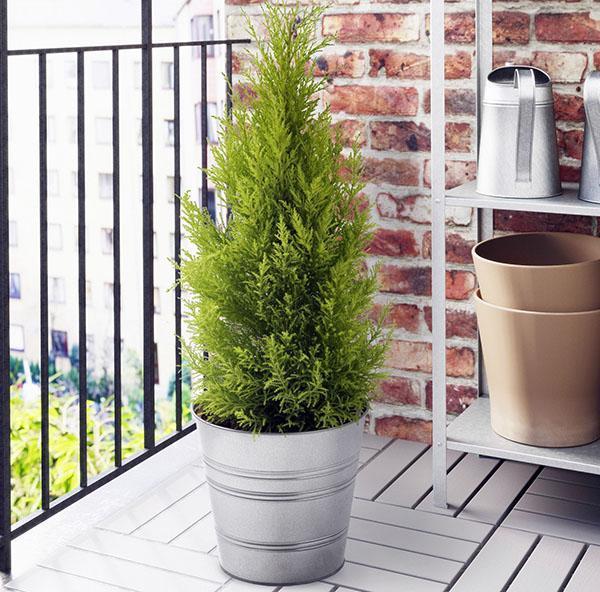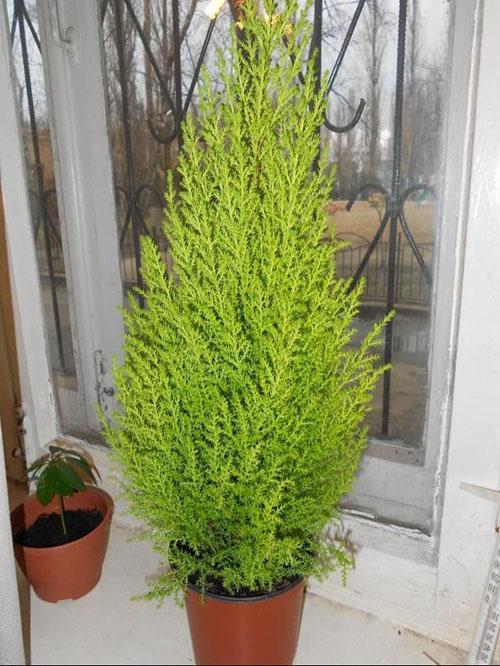Thuja room will find its place in your house
 Thuja indoor is a gymnosperm coniferous plant from the Cypress family. In its natural environment, its height reaches 7 - 12 meters. Thuja was brought to us from North America and Japan. Indoor views will not only add a festive mood for the New Year, but also become a wonderful gift for loved ones and friends. Compared to other conifers, it is not difficult to grow thuja at home.
Thuja indoor is a gymnosperm coniferous plant from the Cypress family. In its natural environment, its height reaches 7 - 12 meters. Thuja was brought to us from North America and Japan. Indoor views will not only add a festive mood for the New Year, but also become a wonderful gift for loved ones and friends. Compared to other conifers, it is not difficult to grow thuja at home.
Room thuja care

Lighting. Thuya in the apartment likes not too bright light. With this in mind, keep the plant near the north windows. In winter and spring, it is necessary to shade the flowerpot from direct sunlight.
 Temperature. In summer, a comfortable temperature is considered to be 20 - 30 degrees. During this period, thuja is useful to grow in the air. Find a shady, draft-free area for her. As for winter, these thermometer indicators for a tree are too high. Make sure that the temperature does not rise above + 15 ° C. Thuja is frost-resistant, but it is better not to expose indoor specimens to the cold test.
Temperature. In summer, a comfortable temperature is considered to be 20 - 30 degrees. During this period, thuja is useful to grow in the air. Find a shady, draft-free area for her. As for winter, these thermometer indicators for a tree are too high. Make sure that the temperature does not rise above + 15 ° C. Thuja is frost-resistant, but it is better not to expose indoor specimens to the cold test.
For planting thuja, you can use a pots.
Humidity. This plant reacts normally to dry indoor air. The heat does not frighten her either. But high temperature and low humidity are not the best combination. Periodically, you still need to spray the plant with a spray bottle.
It is not recommended to grow thuja in plastic, ceramic or metal pots. These materials will not be able to protect the roots of the plant from the cold. They also crack easily.
 The soil. At home, thuja grows well in a pot. You just need to choose the right soil. The best soil for thuja is a mixture with a slightly acidic reaction. You can prepare the ground yourself. For a young plant: take coniferous (2 parts) and leafy soil (4 parts) + sand (1 part). An adult thuja will feel comfortable in such a mixture: prepare the sod land (1 part) + peat (1 part) + sand (1/2 part). The ready-made store substrate has an almost identical composition.
The soil. At home, thuja grows well in a pot. You just need to choose the right soil. The best soil for thuja is a mixture with a slightly acidic reaction. You can prepare the ground yourself. For a young plant: take coniferous (2 parts) and leafy soil (4 parts) + sand (1 part). An adult thuja will feel comfortable in such a mixture: prepare the sod land (1 part) + peat (1 part) + sand (1/2 part). The ready-made store substrate has an almost identical composition.
 Pot. For a thuja that grows indoors, the pot can be anything. The only condition is that the capacity should be taken deeper than the root system itself. This will help the thuja grow properly. It is also worth taking care of the drainage holes in the bottom of the pot. Stagnant moisture is detrimental to this plant. If your thuja will be on a balcony or veranda, pot will have to be chosen carefully. It is best to buy a container that is made of frost-resistant material.
Pot. For a thuja that grows indoors, the pot can be anything. The only condition is that the capacity should be taken deeper than the root system itself. This will help the thuja grow properly. It is also worth taking care of the drainage holes in the bottom of the pot. Stagnant moisture is detrimental to this plant. If your thuja will be on a balcony or veranda, pot will have to be chosen carefully. It is best to buy a container that is made of frost-resistant material.
Sowing seeds in autumn
 Try to propagate thuja using seeds. This is a laborious and rather long process that takes 3 to 5 years. The initial stage is harvesting fresh seeds. This is a prerequisite for good germination.
Try to propagate thuja using seeds. This is a laborious and rather long process that takes 3 to 5 years. The initial stage is harvesting fresh seeds. This is a prerequisite for good germination.
It is best to harvest seeds in late summer or early fall.
You need to have time to collect cones with grains before they begin to open. Then put them in a dry place so that the planting material is completely dry.
The seeds are ready for planting when they begin to easily fall out of the buds (this will take 2 - 3 days). They look small, reddish or brownish in color. The resulting grains must be sown as early as possible. The longer they stay warm, the worse they will emerge later.
 Thanks to this breeding of thuja at home, stratification for crops takes place naturally, which will make the seedlings more viable. Thus, it will grow faster.
Thanks to this breeding of thuja at home, stratification for crops takes place naturally, which will make the seedlings more viable. Thus, it will grow faster.
This will require:
- Fill a wooden box of the optimal size with pre-prepared soil: turf soil (1 part) + peat (2 parts) + fine sand (1/2 part).
- Lay the substrate in an even layer and compact slightly.
- Make deepened grooves every 5 - 6 cm. To make it more convenient to plant seeds, you can expand them at your discretion.
- Distribute the planting material evenly between all grooves. Cover them with a thin layer of earth (about 1 cm) from above.
- Moisten the soil gently with a spray bottle. Your task is not to wash the seeds out of the soil.
Put the box outside, for example, under a tree with a lush crown. The branches of the tree will provide reliable protection from the direct spring sun. Seedling care is very simple: water regularly, protect from direct sunlight and get rid of weeds in a timely manner. As soon as several leaves appear on young plants, the seedlings will need to be planted in separate containers.
After a year, small thuja need to be transplanted. This will allow them to develop quickly and fully. From early summer to autumn, the pots can be kept outside in the shade of a tree.
Thuja propagation by cuttings
 This method is often used by gardeners. This will require semi-lignified twigs. Cut off cuttings only from a healthy plant. They should be separated so that a small part of the bark remains on each element. The longer it is, the better.
This method is often used by gardeners. This will require semi-lignified twigs. Cut off cuttings only from a healthy plant. They should be separated so that a small part of the bark remains on each element. The longer it is, the better.
For rooting, it is better to use a mixture of sand and peat. Both components must be in equal parts. Before placing the elements in the soil, you must remove the lower leaves from them and hold for some time in Kornevin's solution or another growth stimulator.
 Cuttings should be planted in prepared soil at an angle of 600... For quick germination, it is better to cover the container with plastic or a jar on top. You can also use a cut-off plastic bottle. Keep the container at a temperature of about 230 FROM.
Cuttings should be planted in prepared soil at an angle of 600... For quick germination, it is better to cover the container with plastic or a jar on top. You can also use a cut-off plastic bottle. Keep the container at a temperature of about 230 FROM.
To prevent the cutting from disappearing, you need to periodically open the mini-greenhouse. It will take 15 minutes to prevent mold from appearing on the soil surface.
Moisten the earth as needed. This is best done with a spray bottle. Water should be taken only at room temperature and without any impurities. You need to shoot a mini-greenhouse when it will be seen that the thuja has begun to grow rapidly.
 You can also propagate indoor thuja with branches. The procedure is the same as with the handle. In order for the twigs to take root faster, the soil must be calcined before use.
You can also propagate indoor thuja with branches. The procedure is the same as with the handle. In order for the twigs to take root faster, the soil must be calcined before use.
Some experts also use the layering method, but this option is quite complicated and requires effort. This is due to the small space of free soil around the trunk.
Watering and wintering thuja at home
 The most important condition in caring for thuja is proper watering. In return, you will receive a beautiful plant with lush branches. Water the thuja regularly. The earthen ball should always be moist. The plant will not die from dry soil, but it will greatly lose its decorative effect.
The most important condition in caring for thuja is proper watering. In return, you will receive a beautiful plant with lush branches. Water the thuja regularly. The earthen ball should always be moist. The plant will not die from dry soil, but it will greatly lose its decorative effect.
Pruning a plant. This procedure is periodically performed in order to get rid of dry branches. To give the plant a beautiful shape, you can trim it at any time for you, without limiting your imagination.
Thuja care in winter
 The plant easily tolerates cold weather. In winter, at home, she will be better on a glazed balcony, where the temperature will not rise above +10 - +12 degrees. Make sure that the temperature is even, without fluctuations. In order to keep the thuja in a pot in winter, one must remember that it is afraid of drafts and strong winds.
The plant easily tolerates cold weather. In winter, at home, she will be better on a glazed balcony, where the temperature will not rise above +10 - +12 degrees. Make sure that the temperature is even, without fluctuations. In order to keep the thuja in a pot in winter, one must remember that it is afraid of drafts and strong winds.
Thuja is very easy to maintain. She does not need frequent feeding. Organic and mineral fertilizers are applied in turn.In the spring, more attention is paid to nitrogen-containing fertilizers, and in the summer they use potash fertilizers (once a month is enough). Optionally, you can also use phosphate fertilizers... All these dressings have a beneficial effect on the condition of the plant, and you will have beautiful and fragrant needles all year round.
Young thuja are transplanted once a year. Adult specimens are less common when the pot becomes cramped for roots. Better to take a special land for conifers. The transplant is done by the transshipment method. The old soil on the roots must be preserved. It protects them from damage.
Homemade thuja in a pot will be a real decoration for any home or office. It not only looks original in any room, but also perfectly cleans the air.